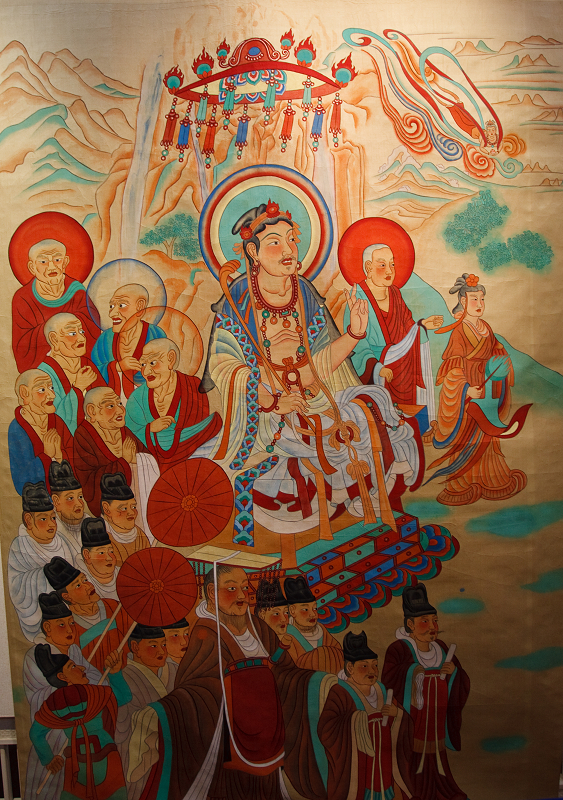|
699
__NOTOC__ Year 699 (Roman numerals, DCXCIX) was a common year starting on Wednesday (link will display the full calendar) of the Julian calendar. The denomination 699 for this year has been used since the early medieval period, when the Anno Domini calendar era became the prevalent method in Europe for naming years. Events By place Umayyad Caliphate * Umayyad Caliphate, Umayyad troops invade Armenia, and secure the submission of Prince Smbat VI Bagratuni. The South Caucasus becomes a viceroyalty called ''Arminiya, al-Arminiya'', and is divided into four regions: Caucasian Albania, Principality of Iberia, Caucasian Iberia, the area around the Aras River, and Taron (historic Armenia), Taron (modern Turkey). Asia * June 26 – En no Gyōja, En no Ozunu, Japanese Asceticism, ascetic, is banished to Izu Ōshima (a Volcano, volcanic island in the Izu Islands), and accused of confusing the mind of the people with Magic (paranormal), magic. He will be later regarded as th ... [...More Info...] [...Related Items...] OR: [Wikipedia] [Google] [Baidu] |
Roman Numerals
Roman numerals are a numeral system that originated in ancient Rome and remained the usual way of writing numbers throughout Europe well into the Late Middle Ages. Numbers are written with combinations of letters from the Latin alphabet, each letter with a fixed integer value, modern style uses only these seven: The use of Roman numerals continued long after the decline of the Roman Empire. From the 14th century on, Roman numerals began to be replaced by Arabic numerals; however, this process was gradual, and the use of Roman numerals persists in some applications to this day. One place they are often seen is on clock faces. For instance, on the clock of Big Ben (designed in 1852), the hours from 1 to 12 are written as: The notations and can be read as "one less than five" (4) and "one less than ten" (9), although there is a tradition favouring representation of "4" as "" on Roman numeral clocks. Other common uses include year numbers on monuments and buildings and ... [...More Info...] [...Related Items...] OR: [Wikipedia] [Google] [Baidu] |
Wang Wei (Tang Dynasty)
Wang Wei (; 699–759) was a Chinese poet, musician, painter, and politician of the middle Tang dynasty. He is regarded as one of the most famous men of arts and letters of his era. Many of his poems survive and 29 of them are included in the 18th-century anthology ''Three Hundred Tang Poems''. Wang Wei is especially known as a poet and painter of nature. Some 400 poems survive. These were first collected and originally edited into a corpus by his next-youngest brother, Wang Jin, by imperial command. Of his paintings, no authenticated specimens survive, although there is evidence of his work through influences on later paintings and descriptive accounts of his paintings. His musical talents were regarded very highly, although nothing survives of his music except reports. He furthermore had a successful career as a court official. Eventually, he became a devout Zen Buddhist and a vegetarian. Wang Wei spent ten years studying with Chán master Daoguang. Names His family name ... [...More Info...] [...Related Items...] OR: [Wikipedia] [Google] [Baidu] |
En No Gyōja
( b. 634, in Katsuragi (modern Nara Prefecture); d. c. 700–707) was a Japanese ascetic and mystic, traditionally held to be the founder of Shugendō, the path of ascetic training practiced by the ''gyōja'' or ''yamabushi''. He was banished by the Imperial Court to Izu Ōshima on June 26, 699, but folk tales at least as old as the ''Nihon Ryōiki'' (c. 800) recount his supernatural powers and exploits. He is also referred to by the name , , or also under the full name En no Kimi Ozunu, where is his kabane or titular name. Historical references Even historical accounts of his life are intermixed with legends and folklore. According to the chronicle ''Shoku Nihongi'' ( 797 AD), En no Ozunu was banished to the island of Izu Ōshima on June 26, 699: On ''hinoto-ushi'' ( sexagenary "fire ox") day Mommu_(period).html"_;"title="4th_day_of_the_5th_month,_Mommu_(period)">Mommu_3_(June_26,_699_AD)_En_no_Kimi_Ozunu_was_banished_to__ Mommu_3_(June_26,_699_AD)">Mommu_(period).htm ... [...More Info...] [...Related Items...] OR: [Wikipedia] [Google] [Baidu] |
Imam Abu Hanifa
Nuʿmān ibn Thābit ibn Zūṭā ibn Marzubān ( ar, نعمان بن ثابت بن زوطا بن مرزبان; –767), commonly known by his '' kunya'' Abū Ḥanīfa ( ar, أبو حنيفة), or reverently as Imam Abū Ḥanīfa by Sunni Muslims, was a Persian Sunni Muslim theologian and juristPakatchi, Ahmad and Umar, Suheyl, "Abū Ḥanīfa", in: ''Encyclopaedia Islamica'', Editors-in-Chief: Wilferd Madelung and, Farhad Daftary. who became the eponymous founder of the Hanafi school of Sunni jurisprudence, which has remained the most widely practiced law school in the Sunni tradition, predominates in Central Asia, Afghanistan, Iran (until the 16th century), Balkans, Russia, Chechnya, Pakistan, Bangladesh, Muslims in India, Turkey, and some parts of the Arab world. Some followers call him ''al-Imām al-Aʿẓam'' ("The Greatest Imam") and ''Sirāj al-Aʾimma'' ("The Lamp of the Imams") in Sunni Islam. Born to a Muslim family in Kufa, Abu Hanifa is known to have travelled to ... [...More Info...] [...Related Items...] OR: [Wikipedia] [Google] [Baidu] |



